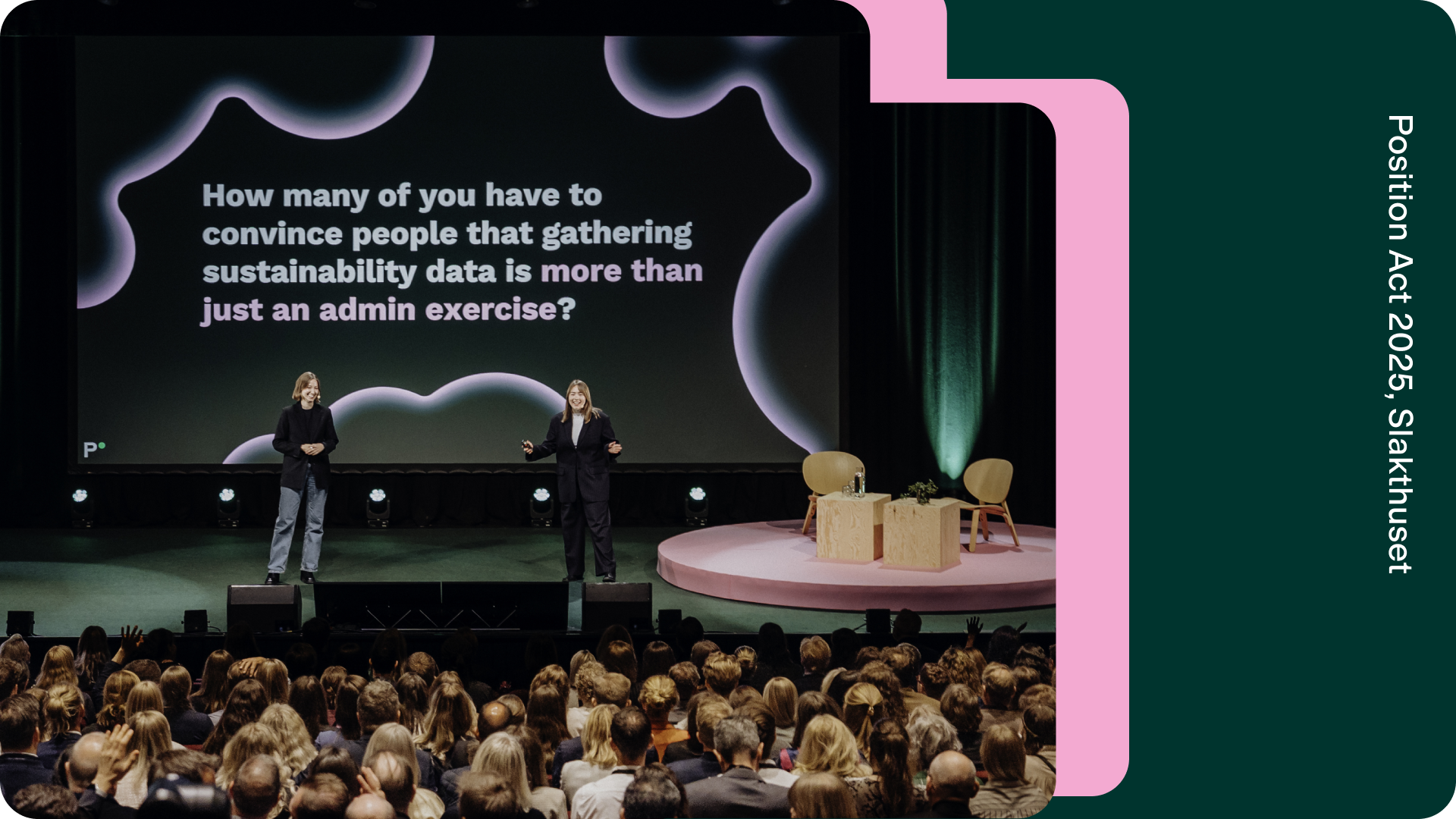Key takeaways from Position Act 2025

As sustainability leaders, policy makers, and impact-driven technologists gathered at Position Act 2025, it was clear the event marked a departure from the compliance-heavy rhetoric that often dominates ESG conversations. Instead, what emerged was a vision of sustainability grounded in operational infrastructure, financial realism, and planetary governance.
Across a packed day of panels, keynotes, and product sessions, one message rang clear: sustainability must be governed like strategy, measured like finance, and communicated like leadership.
1. Sustainability infrastructure is now the battleground for execution
The central strategic theme at Position Act 2025 was that ambition is no longer scarce, but effective execution is the new bottleneck.
“We’ve seen sustainability ambitions go up. But what’s missing is the system that gets you from decision to outcome. That’s the infrastructure Position Green is building.” — Daniel Gadd, CEO, Position Green
In recent years, ESG momentum has surged. But organizations continue to struggle with embedding those goals into day-to-day decision-making. This is where Position Green’s latest platform capabilities take aim—turning auto-reporting into something far more valuable: operational alignment.
“The truth is, ESG is changing shape. It’s no longer a project. It’s a performance system.”
Gadd’s framing resonates with what many in attendance expressed: data without structure doesn’t scale. Automation, audit trails, and cross-functional governance are no longer backend utilities—they’re front-line business systems. The strongest organizations will be those that stop treating sustainability as a silo and start governing it like finance.
New features include decarbonization strategy mapping and scenario modeling tools, AI-powered auto-reporting, and real-time performance benchmarking from Europe’s largest private market data set.
2. ROI is now the primary language of ESG credibility
Another decisive shift at the event came from the ROI roundtable, where the mood was clinical, not aspirational. Anders de Lichtenberg opened the discussion by reframing ESG in investor terms. The room, filled with sustainability directors, financial modellers, and strategy leads, followed suit.
“I think it is super important to do a Double Materiality Assessment (DMA) as it gets the attention of financial stakeholders… One way of prioritizing this is to assess the investments needed to make an impact.” — Anders de Lichtenberg, Managing Director, Denmark, Position Green
The discussion centered around the mathematics of sustainability: IRRs, payback windows, and discounted cash flow models that capture risk-adjusted returns over time.
This kind of language reflects a fundamental evolution: ESG is no longer measured in anecdotes, but in performance terms that finance teams already understand. Participants discussed how value drivers can be modeled across axes like cost savings, regulatory premiums, brand insulation, and tender eligibility.
A key insight emerged around net investor value. By projecting cashflow streams and matching them with ESG milestones, organizations can create financially coherent ESG narratives using tools like carbon accounting.
“This is all crucial as you are then speaking the language of the CFOs that will directly impact the efforts they oversee.”
Crucially, this wasn’t about greenwashing. Participants recognized that the hardest part of sustainability is quantifying ambiguity. But even imperfect projections, framed with rigor and updated with evidence over time, build internal trust.
3. Planetary boundaries are becoming strategic baselines
Science also had its moment at Position Act 2025—but not as a warning. As Johan Rockström spoke live from Berlin, he did not dwell on collapse, but on thresholds. The message: planetary boundaries are not forecasts. They are operational zones.
“Six of nine planetary boundaries have been transgressed. We are now operating in a danger zone. We are destabilizing the very systems that support the well-being of current and future generations.”

“1.5 degrees is not a goal. It’s a physical limit.”
Johan Rockström – Professor in Earth System Science
He also highlighted the importance of the social costs of carbon, and advocated for what he termed a “planetary health check.”
And yet, Rockström’s tone was technical, not theatrical. He emphasized that these boundaries, though daunting, are ultimately tools for corporate governance. Knowing which boundaries we’re approaching helps businesses manage exposure, scenario-test strategies, and build resilience.
“This isn’t about fear—it’s about staying within safe operating limits. That’s good risk governance.”
4. From complexity to coherence: Ocean strategies and system thinking
In the same spirit, we hosted a live podcast episode of Sustainable Edge, featuring Florian Dirkse, Co-founder of The Ocean Cleanup, as he retold his journey from a two-year sailing voyage to founding one of the largest ocean restoration projects in the private sector.
Joachim Nahem, Chair of the Advisory Board at Position Green and podcast host, explored the complexity of large-scale environmental intervention alongside Florian through the lens of ocean sustainability. Their conversation mirrored the realities many sustainability professionals face: complex supply chains, myriad stakeholders, and oceans of disaggregated data, all of which benefit from solutions like supplier assessment tools.
“You can’t simplify complexity—but you can organize around it.” — Florian Dirkse, Co-founder, The Ocean Cleanup
This thread ran through multiple conversations: successful sustainability leadership doesn’t eliminate complexity. It builds systems capable of adapting within it.
5. Reconnecting to purpose: From hype cycles to long-term strategy
In the face of shifting political landscapes and regulatory pauses, many speakers at Position Act 2025 urged organizations to return to the foundation of their sustainability work: purpose. Rather than treating this as an era of retreat, they framed it as a time to reaffirm long-term direction and resist reactive thinking.
Andreas Rasche warned against falling into “sustainability silence” as political pressure mounts.
“Simplification has become a word politicians use to pull back regulations. But don’t retreat into sustainability silence.”
He urged organizations to anchor in values and push forward, offering three actions for impact: stay vocal, revisit your core mission, and maintain long-term strategic focus. When the day was coming to an end, Julia Staunig echoed this compelling call for organizations to revisit their “why”:
“Execution readiness is the differentiator now. Not perfection, not completeness—readiness.”

“Reframe everything in words that don’t trigger backlash: risk, opportunity, transparency.”
Julia Staunig – Chief Growth Officer
“Go back to the why. Personal why to build personal resilience. Your company’s why. The purpose, vision and mission… Reframe everything in words that don’t trigger backlash: risk, opportunity, transparency.”
In today’s climate, she argued, silence can be more damaging than missteps. And the language of sustainability needs to be strategically tuned to resonate in boardrooms under pressure.
“There’s a risk in waiting. If you’re only preparing for one scenario, you’ll be caught off guard by the others.”
Conclusion: The end of ESG as exception
Position Act 2025 made one thing abundantly clear: ESG is no longer the exceptional case. It is the operating context.
From infrastructure to incentives, from planetary science to boardroom finance, sustainability has moved into its systems phase. The companies that will lead from here are not the ones with the loudest goals, but those with the clearest architecture to meet them.
“You have to decide now—are you reporting because you have to, or because you understand the strategic importance of doing so?” — Andreas Rasche
And putting yourself in the position to act upon this is predicated upon treating your green data as crucially as your other data, such as those of your finance or from your customers.


